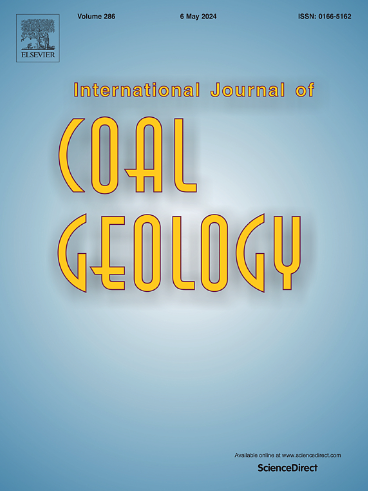哈萨克斯坦Ekibastuz盆地下石炭统煤的有机岩石学与地球化学
IF 5.7
2区 工程技术
Q2 ENERGY & FUELS
引用次数: 0
摘要
Bogatyr Komin露天煤矿位于哈萨克斯坦东北部的Ekibastuz盆地,是世界上最大的煤矿之一。它是基于三个下石炭统煤层(从下到上:煤层3、2和1),它们共同形成了一个150米厚、均匀的煤层复合体。在盆地西缘研究点,煤层倾角较大。通过有机岩石学和地球化学调查,确定了这些异常厚煤层的成熟度和沉积环境。镜质体反射率(0.8 ~ 1.1% Rr)将煤分类为高挥发性烟煤,Tmax值和成熟度相关生物标志物比值也支持了这一分类。镜质组反射模式证明了变形前煤化作用和相对较高的古热流,可能是岩浆活动引起的。灰分产率高,硫含量相对较低,表明煤是在低洼矿井中积累的,没有受到海洋的影响。碎屑矿物的输入在泥炭堆积过程中减少。相对高浓度的含硫芳香化合物,特别是在煤层3的下部,可能反映了火山活动,这也可以从煤样中明显的灰层(“高岭石层”)和高岭石的存在中得到证明。形成泥炭的植被中很少有厚的成木植物。然而,接缝1和接缝3的样品含有高浓度的芳香族化合物,这些化合物来自木质素的乔木堇青树-针叶树-蕨类植物。在煤层2和煤层1上部沉积过程中,细菌活性增强,表明藿烷浓度升高。煤杂岩体的异常厚度表明了一个高沉降率的地球动力学背景。本文章由计算机程序翻译,如有差异,请以英文原文为准。
Organic petrography and geochemistry of the Lower-Carboniferous coals from the Ekibastuz Basin, Kazakhstan
The Bogatyr Komin open-pit mine in the Ekibastuz Basin, located in north-east Kazakhstan, is one of the largest coal mines in the world. It is based on three Lower Carboniferous seams (from bottom to top: seams 3, 2, and 1), which together form a 150 m thick, uniform seam complex. At the study site on the western basin edge, the seams dip steeply. Organic petrological and geochemical investigations have been performed to determine the maturity and depositional environment of these exceptionally thick seams.
Vitrinite reflectance (0.8–1.1 %Rr) classifies the coal as high-volatile bituminous A coal, which is also supported by Tmax values and maturity-related biomarker ratios. Vitrinite reflectance patterns prove pre-deformational coalification and a relatively high paleo-heat flow, likely caused by magmatic activity.
High ash yields and relatively low sulfur contents indicate that the coal accumulated in low-lying mires without marine influence. The input of detrital minerals decreased during peat accumulation. Relatively high concentrations of sulfur-bearing aromatic compounds, particularly in the lower part of seam 3, may reflect volcanic activity, which is also evidenced by the presence of distinct ash layers (“kaolinitic beds”) and kaolinite in coal samples.
Thick wood-forming plants were rare in the peat-forming vegetation. However, samples from seams 1 and 3 contain higher concentrations of aromatic compounds derived from lignin-bearing arborescent cordiaite-conifer-pteridosperm vegetation. Enhanced bacterial activity during deposition of the upper part of seam 2 and seam 1 is indicated by elevated hopane concentrations.
The exceptional thickness of the coal complex indicates a geodynamic setting with high subsidence rates.
求助全文
通过发布文献求助,成功后即可免费获取论文全文。
去求助
来源期刊

International Journal of Coal Geology
工程技术-地球科学综合
CiteScore
11.00
自引率
14.30%
发文量
145
审稿时长
38 days
期刊介绍:
The International Journal of Coal Geology deals with fundamental and applied aspects of the geology and petrology of coal, oil/gas source rocks and shale gas resources. The journal aims to advance the exploration, exploitation and utilization of these resources, and to stimulate environmental awareness as well as advancement of engineering for effective resource management.
 求助内容:
求助内容: 应助结果提醒方式:
应助结果提醒方式:


